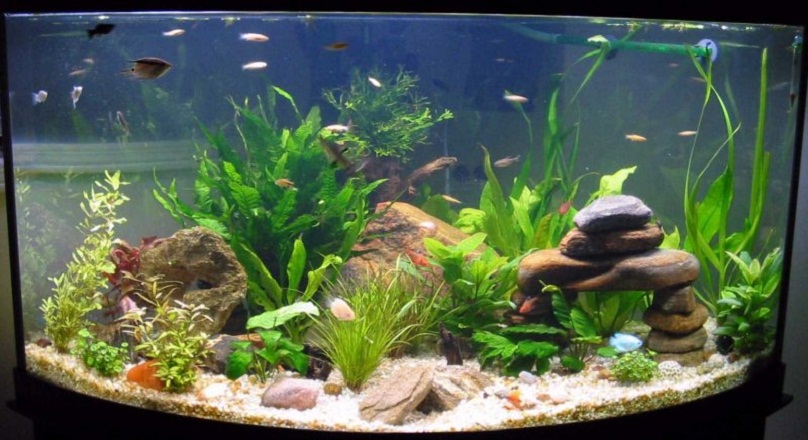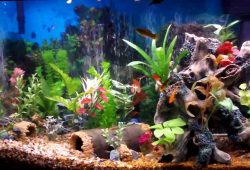Fish Tank Decorations: a Fish’s Perspective
This article is about Fish Tank Decorations: a Fish’s Perspective. There are many ways to decorate a fish tank, and an almost infinite number of objects one can buy as decorations. This can make choosing difficult, especially if this is your first aquarium.

Decorating the tank is important because it will affect how much enjoyment you get out of looking at the tank, and it will also affect how happy your fish are. After all, while the tank is your hobby, it is their home and their world. In nature, fish use the objects around them in multiple different ways, the exact objects and the types of use being dependent on the species. The most important uses are for hiding and for breeding.
Many fish hide from predators in the wild to escape being eaten, and from more dominant members of their own species to escape being bullied. While hopefully you have not included any predators in their tank, many species of fish will feel much happier if there is somewhere they can hide. This does not mean that they will spend all their time hiding where you cannot see them.
In many cases, the simple knowledge that the hiding spot is available will be all that is needed to keep them happy and interacting with other fish in full view of you the owner. Their happiness may be seen in brighter colors and more interesting behavior, as well as increased resistance to disease. I make its standard policy to include potential hiding places in all of my tanks.
Different species have different needs when it comes to hiding places. Hiding places are often very important to territorial fishes as they provide refuges for weaker fishes. Such refuges lower stress levels and can save lives. Shy species also appreciate hiding places.
Mid-water schooling fish do not make much use of hiding places because their hiding place is amongst a group of fish of the same species. They are best served by an area of open water large enough to school in, and by the presence of other members of the same species. Examples of such species include danios, many barbs and many tetras. However, sometimes there will be bullying within the group, and then the bullied fish may find the hiding places useful so I still prefer to have hiding places available.
Nocturnal fish do have a tendency to hide in dark places in the tank during the day, but depriving them of hiding places will not make them be happily active during daylight. If you want to keep nocturnal fish, you need to be prepared for them to sleep during the day and be active at night. If you use a red light at night in an otherwise dark tank, you should be able to watch them move about.
Examples of such fishes include many catfishes, although not the genus corydoras. If you want fish that are active during the day, you need to buy fish that are active during the day. The vast majority of tropical fish you will find at your local pet store are active during the day so it is not hard to do.
Hiding places often include thick clumps of plants, and caves formed by rocks or wood. Such settings can be duplicated in the aquarium, or almost any dark confined space can be used by the fish. Flowerpots turned on their side and half buried in the gravel, or completely upside down with entry through the hole in what is normally considered the bottom of the pot can be used as caves by many fishes and are easy to acquire and use.
Aquarium fish do not care, at least as far as we know, whether plants are real or plastic so long as they are thick enough to make a good hiding spot. I am especially fond of oddly shaped pieces of driftwood, as they form multiple caves, are natural in the habitats of the fish I keep, and look really good when paired with live plants.
If you wish to breed fish, you may find that certain objects are essential for particular fish species. For example, many fish lives like to breed in caves, and will require an overturned flowerpot or rocky cave in which to lay their eggs. Some catfishes and Cichlids fall into this category. Egg depositors need a clean flattish surface on which to deposit their eggs.
Some will do this directly onto the aquarium glass, but many owners prefer to have the fish lay their eggs on an object which can be removed for separate hatching, such as a piece of slate (Mills, 1987). Of course, fishes often have their own ideas and may insist on laying their eggs on the heater or the glass no matter what more suitable objects you put in. Many fishes are egg scatterers.
Some of these scatter their eggs among plants where the sticky eggs stick to the plants, or use floating plants as part of a bubble nest. Many eggs scatterers will eat their own eggs, and thick clumps of plants help protect the eggs from the hungry parents (Mills, 1987). Some breeders use nylon mops instead, and these apparently work just as well. Most people consider them less decorative than plants so they are usually used only in dedicated breeding tanks.
A few fishes have extremely specialized needs: there are certain African Cichlids that normally lay their eggs inside large snail shells, so if you want them to breed you will have to provide such shells, and there are even a few fishes that lay their eggs in other fishes nests where the young are reared by a different species. With regards to breeding and tank decorations, the tank decorations required are determined by the species of fish you wish to breed.



